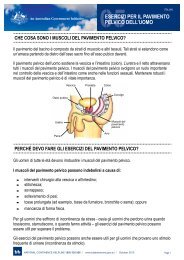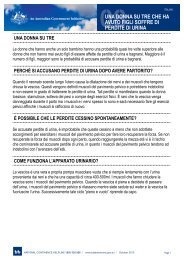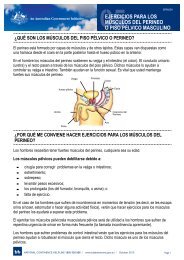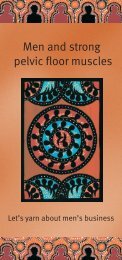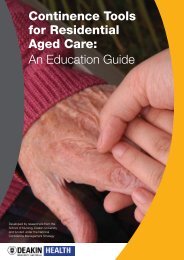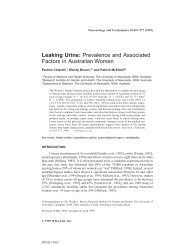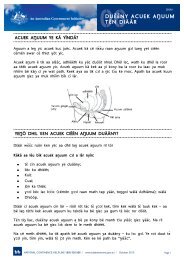Pharmacy Continence Care - Bladder and Bowel Website
Pharmacy Continence Care - Bladder and Bowel Website
Pharmacy Continence Care - Bladder and Bowel Website
Create successful ePaper yourself
Turn your PDF publications into a flip-book with our unique Google optimized e-Paper software.
One pharmacy indicated involvement in a previous project (the Hunter pilot). Later<br />
recruitment also enlisted another three pharmacies that had been involved in the Tasmanian<br />
Divisions of General Practice project.<br />
3.4 Timeframes<br />
The recruitment of pharmacies commenced in October 2004 <strong>and</strong> was finalised during<br />
January 2005. Once the NOVA staff identified that the most effective way to communicate<br />
with pharmacies was by fax <strong>and</strong> by telephone, preferably in the morning, communication<br />
became streamlined. Email is not a form of communication commonly used by pharmacies<br />
<strong>and</strong> was discarded as ineffective for this group.<br />
The <strong>Pharmacy</strong> Initial Questionnaire (PIQ) was administered to pharmacies during March<br />
2005 at the same time as the training materials were being finalised <strong>and</strong> sent out <strong>and</strong> the<br />
train-the-trainer program was being provided to the trainers.<br />
Due to availability of both pharmacies <strong>and</strong> training staff, training commenced in mid April<br />
<strong>and</strong> was completed by the end of the first week in May. The different timing of school<br />
holidays across the jurisdictions became an unexpected consideration for timing of the<br />
training program.<br />
Three months after the completion of training at each pharmacy, the <strong>Pharmacy</strong> Exit<br />
Questionnaire (PEQ) was administered by telephone (August 2005). Thirty-two of the 46<br />
participating pharmacies were interviewed for the PEQ. Follow-up calls endeavouring to<br />
arrange an interview time were made to each of the non-responding pharmacies. Two to<br />
three telephone calls were required to secure an interview time, <strong>and</strong> non-responding<br />
pharmacies were unable to provide firm time for interview by the nominated staff member<br />
within the time period for the follow-up survey.<br />
3.5 <strong>Pharmacy</strong> implementation of the Program<br />
As part of the Program, pharmacies were encouraged to seek feedback from their customers<br />
to gauge their satisfaction with the service they received from the pharmacy in relation to<br />
continence care. A template for a customer feedback questionnaire was provided in the<br />
training materials. Sixteen of the 32 respondents to the PEQ had sought such feedback (see<br />
Figure 6).<br />
16.2<br />
16<br />
15.8<br />
15.6<br />
15.4<br />
15.2<br />
15<br />
14.8<br />
14.6<br />
14.4<br />
Pharmacies that collected feedback from customers<br />
16<br />
15<br />
YES NO<br />
Pharmacies that<br />
collected feedback from<br />
customers<br />
Figure 6: Pharmacies that collected feedback from customers<br />
Of those pharmacies that had sought feedback, eleven (69 per cent) reported that<br />
customers had expressed satisfaction with services provided to them. This is a reflection of<br />
pharmacy perception of consumer satisfaction <strong>and</strong> not a collected data item, as the project<br />
Final Report<br />
17<br />
NOVA Public Policy<br />
<strong>Pharmacy</strong> <strong>Continence</strong> <strong>Care</strong> Project



